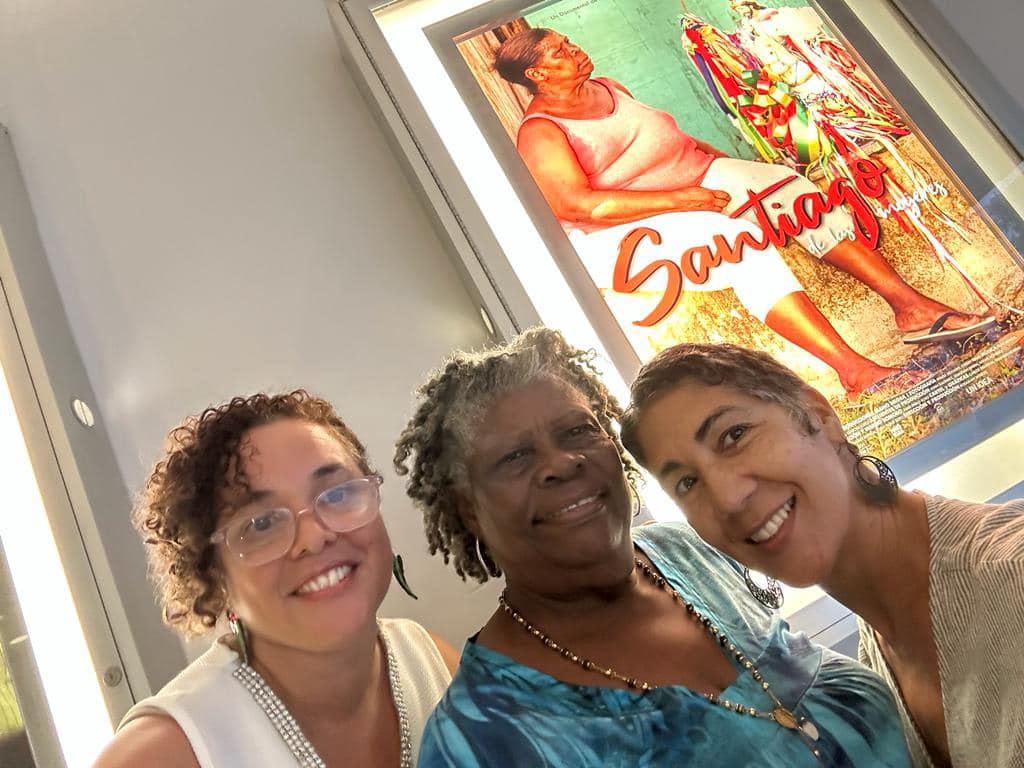Featured at the Philadelphia Latino Film Festival (PHLAFF), Santiago de las Mujeres is a love letter to a community and its cultural heritage. Set in the vibrant coastal town of Loíza, Puerto Rico, against the backdrop of their annual spiritual tradition honoring Santiago el Apóstol (Saint James the Apostle), the documentary follows the lives of eight devoted women.
For a closer look at this poignant piece, I met with the film’s director and producer, Rosamary Berríos Hernández. In this interview, she shares perspectives on the richness of her Afro-Caribbean cultural identity, the nuances of cinematography, and the importance of telling our stories.
LOLA ROSARIO: Can you give a brief background about the tradition you depicted in Santiago de las Mujeres and share what prompted you to start this project?
ROSAMARY BERRÍOS HERNÁNDEZ: Our week-long, annual July festival is a tradition paying tribute to Santiago Apóstol. Over three consecutive days, there are processions commemorating each of its representations: [Day 1] Santiago de los Hombres, [Day 2] Santiago de las Mujeres, and [Day 3] Santiago de los Niños. While we understand it was originally brought to Puerto Rico from Spain, what we celebrate in Loíza is inherently ours and represents our rich African ancestry.
The project began back in 2014, wanting to explore the spiritual tradition as a parallel to the lives of these women and their devotion to Santiago Apóstol. It goes beyond religion. By documenting their family history, joys, and struggles, the film centers on their role as pillars of our community. My intention was to capture the town’s essence through the eyes and experiences of these strong femmes.
LOLA ROSARIO: Having an all-female cast must have been beautifully empowering. Talk to me about how you chose the women.
ROSAMARY BERRÍOS HERNÁNDEZ: Growing up in Loíza, I knew all of these women as fixtures in our barrios. Whether it was via mutual family connections, spending time together at local cultural events, or living across the road from each other, they were accessible. It didn’t happen overnight, though. I observed them over the years — I also often saw them at Santiago festivals. So, with time, I grew more comfortable until I was prepared to approach them. Interestingly, I knew these were the perfect persons to share their experiences as well as their life philosophy.
LOLA ROSARIO: Living in Loíza, I’m fortunate to have met a few of the personas in the documentary. What was it like to center women and our Afro Puerto Rican cultural identity on the screen?
ROSAMARY BERRÍOS HERNÁNDEZ: For me, there was no question — the film’s focus had to be these women. Inheriting family traditions from their mothers and grandmothers, the responsibility of honoring Santiago is etched in their hearts. We wanted that to come through on the screen.
Two decades ago (while working on my Master’s degree), I lived in Cuidad México. During those four years, I learned a lot about myself. Dealing with self-esteem issues, I often questioned my place in the world. Being away from Puerto Rico offered me a different perspective — it taught me to use my lived experiences as a loíceña to speak about our Caribbean identity. Armed with a greater appreciation for who I was (and who I am), I now had agency over my own story and felt encouraged to explore what it means to be Afro Caribeña.
Thinking about our colonial situation and how we are facing erasure, I realized that cinematography would be my resistance tool. It would be a vehicle to show the beauty of our Caribbean heritage and the magnificence of our negrura.
LOLA ROSARIO: Tell me a little bit about the production’s creative process.
ROSAMARY BERRÍOS HERNÁNDEZ: Local cinema has limited resources. In our case, it was further complicated because of Hurricane María’s destruction. The entire process from production to post-production took eight years. For this project, I chose an experimental angle. The purpose was never to offer much history behind the festival itself. Rather, I simply wanted the audience to know there are three processions, of which Santiago de las Mujeres was the feature’s focus.
With this film, I didn’t want the audience to be passive. Switching the placement of the narrative (putting it at the beginning) helped me achieve viewer engagement. By presenting the festival at the beginning of the documentary, the audience is immediately drawn in. For some, they begin to summon memories of having experienced the festival (whether in their childhood or adult lives).
LOLA ROSARIO: What advice would you give to Latina/e femmes interested in pursuing a career behind the camera?
ROSAMARY BERRÍOS HERNÁNDEZ: I believe artistic projects should be self-reflective. An artist’s intimate desire to fulfill a personal need bridges connections between their work and an audience. I would tell emerging femme artists to defend and evolve their ideas — even when they have doubts. Be persistent. Tenacity is a crucial reminder that what they’re doing has purpose.

